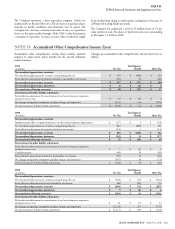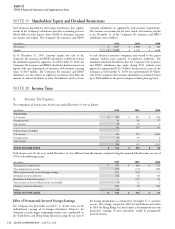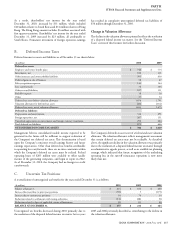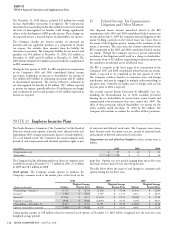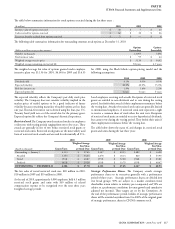Cigna 2010 Annual Report Download - page 143
Download and view the complete annual report
Please find page 143 of the 2010 Cigna annual report below. You can navigate through the pages in the report by either clicking on the pages listed below, or by using the keyword search tool below to find specific information within the annual report.CIGNA CORPORATION 2010 Form 10K 123
PART II
ITEM 8 Financial Statements and Supplementary Data
Other possible regulatory and legislative changes or judicial decisions
that could have an adverse eff ect on the Company’s employee benefi ts
businesses include:
•additional mandated benefi ts or services that increase costs;
•legislation that would grant plan participants broader rights to sue
their health plans;
•changes in public policy and in the political environment, which
could aff ect state and federal law, including legislative and regulatory
proposals related to health care issues, which could increase cost and
aff ect the market for the Company’s health care products and services;
and pension legislation, which could increase pension cost;
•changes in Employee Retirement Income Security Act of 1974
(“ERISA”) regulations resulting in increased administrative burdens
and costs;
•additional restrictions on the use of prescription drug formularies and
rulings from pending purported class action litigation, which could
result in adjustments to or the elimination of the average wholesale
price or “AWP” of pharmaceutical products as a benchmark in
establishing certain rates, charges, discounts, guarantees and fees for
various prescription drugs;
•additional privacy legislation and regulations that interfere with
the proper use of medical information for research, coordination of
medical care and disease and disability management;
•additional variations among state laws mandating the time periods and
administrative processes for payment of health care provider claims;
•legislation that would exempt independent physicians from antitrust
laws; and
•changes in federal tax laws, such as amendments that could aff ect the
taxation of employer provided benefi ts.
e employee benefi ts industry remains under scrutiny by various state
and federal government agencies and could be subject to government
eff orts to bring criminal actions in circumstances that could previously
have given rise only to civil or administrative proceedings.
Guaranty fund assessments. e Company operates in a regulatory
environment that may require the Company to participate in
assessments under state insurance guaranty association laws. e
Company’s exposure to assessments is based on its share of business it
writes in the relevant jurisdictions for certain obligations of insolvent
insurance companies to policyholders and claimants. For the years
ended December 31, 2010, 2009 and 2008, charges related to
guaranty fund assessments were not material to the Company’s results
of operations.
e Company is aware of an insurer that is in rehabilitation, an
intermediate action before insolvency. As of December 31, 2010,
the regulator had petitioned the state court for liquidation and the
Company believes it is likely that the state court will rule on insolvency
for this insurer within the next twelve months. If the insurer is declared
insolvent and placed in liquidation, the Company and other insurers
may be required to pay a portion of policyholder claims through
guaranty fund assessments from various states in which the Company’s
insurance subsidiaries write premiums. Based on current information
available, which is subject to change, the Company has estimated
that potential future assessments could decrease its future results of
operations by up to $40 million after-tax. e ultimate amount
and timing of any future charges for this potential insolvency will
depend on several factors, including the declaration of insolvency
and the amount of the potential insolvency, the basis, amount and
timing of associated estimated future guaranty fund assessments
and the availability and amount of any potential premium tax and
other off sets. Cash payments, if any, by the Company’s insurance
subsidiaries are likely to extend over several years. e Company will
continue to monitor the outcome of the court’s deliberations and
may record a liability and expense in a future reporting period.
E. Litigation and Other Legal Matters
e Company is routinely involved in numerous claims, lawsuits,
regulatory and IRS audits, investigations and other legal matters
arising, for the most part, in the ordinary course of the business of
administering and insuring employee benefi t programs including
payments to providers and benefi t level disputes. Litigation of income
tax matters is accounted for under FASB’s accounting guidance for
uncertainty in income taxes. Further information can be found in
Note 20. e outcome of litigation and other legal matters is always
uncertain, and outcomes that are not justifi ed by the evidence can
occur. e Company believes that it has valid defenses to the legal
matters pending against it and is defending itself vigorously.
In accordance with applicable accounting guidance, when litigation
and regulatory matters present loss contingencies that are both
probable and estimable, the Company accrues the estimated loss by
a charge to income. In such cases, there may also be an exposure to
loss in excess of the amounts accrued. If it is reasonably possible that
a material adverse outcome could develop in excess of any amounts
accrued, the matter is disclosed. In many proceedings, however, it
is inherently diffi cult to determine whether any loss is probable or
even possible or to estimate the amount of any loss. As a litigation
or regulatory matter develops, the Company monitors the matter
for further developments that could aff ect the amount previously
accrued, if any, and updates such amount accrued or disclosures
previously provided as appropriate.
Based upon its current knowledge, and taking into consideration
its current accruals, the Company believes that the legal actions,
proceedings and investigations currently pending against it should
not have a material adverse eff ect on the Company’s results of
operation, fi nancial condition or liquidity other than possibly the
matters referred to in the following paragraphs. However, in light
of the uncertainties involved in these matters, there is no assurance
that their ultimate resolution will not exceed the amounts currently
accrued by the Company and that an adverse outcome in one or
more of these matters could be material to the Company’s fi nancial
statements, results of operation, fi nancial condition or liquidity for
any particular period.
Broker compensation. Beginning in 2004, the Company, other
insurance companies and certain insurance brokers received
subpoenas and inquiries from various regulators, including the
New York and Connecticut Attorneys General, the Florida Offi ce of
Insurance Regulation, the U.S. Attorney’s Offi ce for the Southern
District of California and the U.S. Department of Labor relating
to their investigations of insurance broker compensation. CIGNA
cooperated with the inquiries and investigations.
On August 1, 2005, two CIGNA subsidiaries, Connecticut
General Life Insurance Company and Life Insurance Company
of North America, were named as defendants in a multi-district
litigation proceeding, In re Insurance Brokerage Antitrust Litigation,


